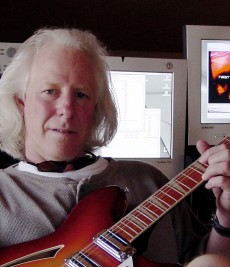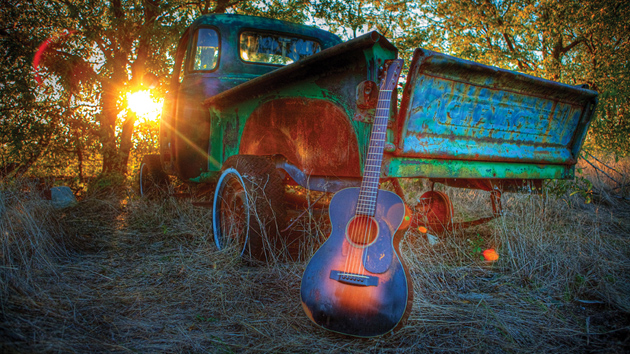
The Composer's New Photo Book is the History of His Guitars
Call him a composer, a musician, a sonic stylist, or even just a "jingle writer." (That last one is how WIkipedia describes him.) Even if you don't think you know his work, you probably know his work — his clients include CNN, CBS, ABC News, The Weather Channel, and ESPN. Stephen Arnold has made himself an industry fixture not just by building a successful music production company out of McKinney, Texas, but by advancing the strategy of "sonic branding" both in his original work and through lectures and workshops. Arnold makes the case for how effectively a well-executed sonic strategy can get in people's heads in a way that visual branding alone can't manage.
Arnold's sense for sound comes to the fore in a different way in a recent project that qualifies as a detour for the prolific songwriter. A Story of Six Strings is a coffee-table book of photographs by Chris Fritchie of rare guitars from Arnold's personal collection. Each guitar gets a different pictoral setting that communicates something of the instrument's history, its sound, and its meaning to Arnold himself. At the top of this page, you can see a 1934 Martin 018 leaned against a rusted Chevy in Frisco, Texas. An 1840 Nicolas Henry parlor guitar is pictured in an alleyway in Santa Fe, New Mexico. A 1969 Frender Strat that Arnold bought from a now-destroyed music store in New Orleans right before Hurrican Katrina is pictured alongside the original score for The Weather Channel's Storm Alert. The result is an evocative, sometimes surprising, chronicle of a career in music.
We asked Arnold about the book project, some of his best recent work, and the mixed blessings of digital audio technology.
SD: You're a composer, but books are silent. What drew you to the idea of a book of photographs of your guitars?
Stephen Arnold: The photographer Chris Fritchie thought it would be interesting to tell the story of Stephen Arnold Music through the backdrop of all these guitars I had compiled through the years. I had never thought about how they would look in a picture. Many sit in cases, so the idea of pulling all out and seeing them in one place was kind of intriguing and brought on a flood of memories.
How did you connect with Fritchie?
I knew him through some mutual music friends and performers, as Chris often shot various music venues. He called me last year and said, ‘I have this idea — can I borrow a few guitars’? A few days later, he asked me if there were any stories behind the guitars, which I had never really thought about. It was never about the most expensive guitar or most unique guitar, but how these instruments are more about a moment, a place in time. The next week he showed up at the studio with a large print of the “Katrina” guitar and “My Favorite Martin.” The rest is history.
As evidenced by the photos assembled in the book, your collection is extensive. How much impact does the character of a particular instrument have on the emotional content of a musical piece?
A bunch. With me, it happens more in the writing stage as, depending on the assignment, the character — or DNA — of the guitar greatly inspires creative process. For example the "God Bless Louisiana" music/campaign (a Promax Gold award-winner) just couldn't be written on one of those older parlor guitars, nor could the Peter Jennings "In Search Of America" or CNN's "Remembering 9/11" this past fall have been written on a '69 Strat or a cool Tele. The feel and sound of the guitar very much sets the creative foundation for the notes and chords that follow. There’s something about the vibration of those strings that has the ability to stir up, inspire, provoke, and awaken a variety of emotions.
Tell us about one of the most successful projects you've completed recently, and what elements made it so effective.
Two shows for CNN that were totally different. Erin Burnett OutFront on CNN has a kind of raw indie band sound and a great five-note hook. The Jane Velez-Mitchell theme is totally different — mostly electronic and a bit more urban sounding. She actually played a cool riff on her iPad, which we took and expanded. CCTVA (China Central Television America) launched three totally different shows we did music for: Americas Now combined flamenco guitar and Latin percussion with a hint of tension; the theme for the current-affairs talk show The Heat features distorted electric guitars over charging rhythms and electronic elements; and the daily global news show Biz Asia America uses piano hooks and mid-tempo groove. The final decision-makers were in Beijing and spoke almost no English, which was quite a challenge.
What's on your agenda for NAB this year?
We will mainly be roaming and meeting with many of our international reps ("sub publishers"), as we are putting more focus on our production music library, "The Vault," and we’ll use NAB to help get the word out.
You recently posted a blog entry touting the "warmth and expansiveness" of vinyl records. Do you still use analog recording technology? If so, when is it most appropriate?
People sometimes ask, "What comes first, the words or the music?" I tell them, "It's the deadline." Unfortunately the deadlines seem to take priority over the art and sound of analog. The digital gear is so much more flexible. It's faster and allows for last-minute changes, which are frequent in this business. We do have a number of analog pre-amps and tube outboard gear, which helps, but no, nothing gets printed or ‘magnetized’ to tape anymore. I do wish we still had our old Studer and MCI two–inch 24-tracks. That would be sweet.
How is new technology changing the way you work?
Everything can be done faster and cheaper — or so clients keep telling us. The problem is that it allows you to delay spontaneous decisions as you save layers and layers of takes, instead of trusting your initial instincts. Singers can sing out of tune and be corrected later. Even some instruments, as well. Whole tracks can be transposed. Science is literally sucking the life out of the art. (Now you got me going.) Listeners and viewers are becoming more and more desensitized to great music as they hear so much "programmed" and electronic music and listen to MP3s on cheap earbuds. I’m not so sure stringing together loops, pads and textures can be called composing. For me, technology often gets in the way as so much time is spent turning knobs and scrolling through sounds, menus and windows, instead of working out the actual notes and melody. I typically go straight to the raw guitar or acoustic piano, work out the "idea," then use the technology to execute it. But everyone’s different. It's all subjective. There's been some great music recorded in bedrooms.
For more on A Story of Six Strings, visit: www.astoryofsixstrings.com; for more on Stephen Arnold Music, visit: www.stephenarnoldmusic.com
Did you enjoy this article? Sign up to receive the StudioDaily Fix eletter containing the latest stories, including news, videos, interviews, reviews and more.











Leave a Reply